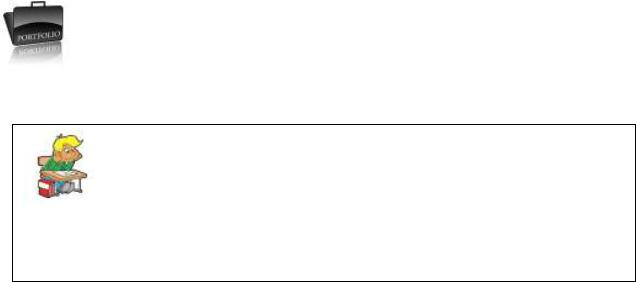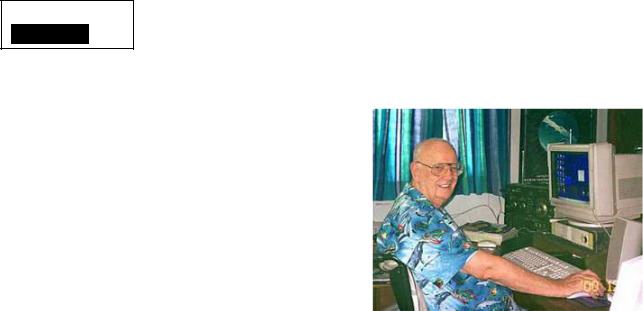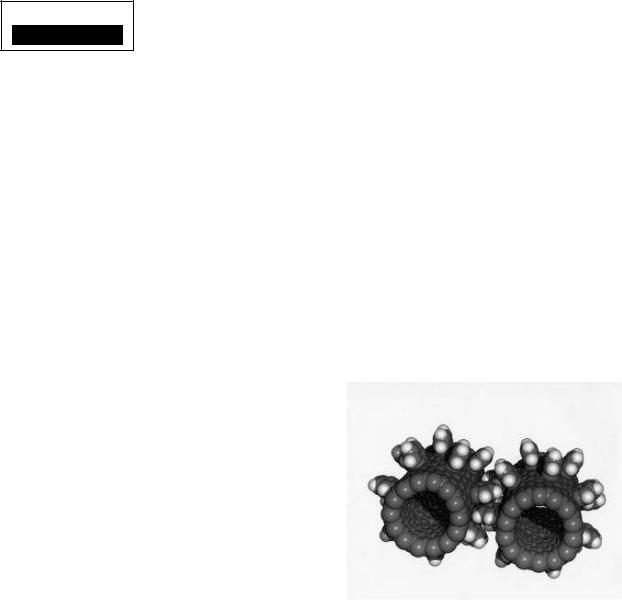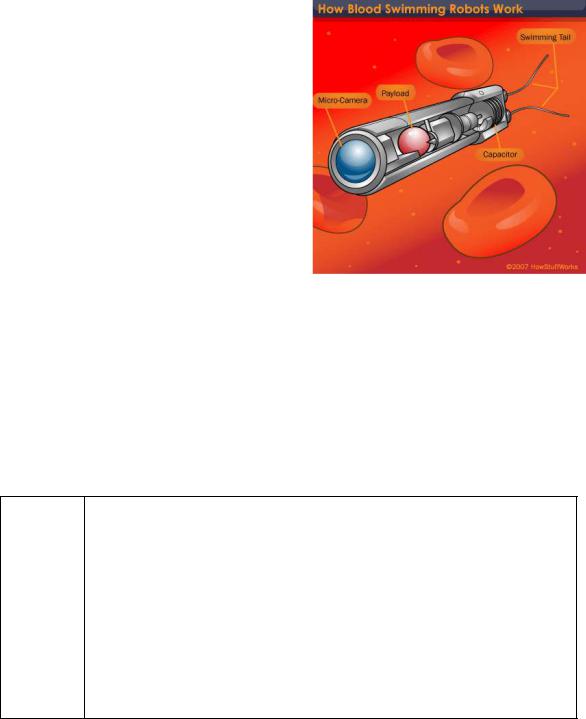
8633
.pdf
10
Compare your definitions with the ones given by www.dictionary.com.
A robot is
1.a mechanical device that sometimes resembles a human and is capable of performing a variety of often complex human tasks on command or by being programmed in advance.
2.a machine or device that operates automatically or by remote control.
2.Do you know in what sphere the first robot was used? Work in pairs. Make a list of spheres where robots are used now.
3.Read the extract and compare it with your list.
Stories of artificial helpers and companions and attempts to create them have a long history but fully autonomous machines only appeared in the 20th century. The first digitally operated and programmable robot, the Unimate, was installed in 1961 to lift hot pieces of metal and stack them. Today, commercial and industrial robots are in widespread use performing jobs more cheaply or with greater accuracy and reliability than humans. They are also employed for jobs which are too dirty, dangerous or dull to be suitable for humans. Robots are widely used in manufacturing, assembly and packing, transport, earth and space exploration, surgery, weaponry, laboratory research, and mass production of consumer and industrial goods. Domestic robots for cleaning and maintenance are increasingly common in and around homes.
(Adapted from www.wikipedia.org )
Activity 1.7
Vocabulary focus
1. Match the words in the columns to make word combinations.
intelligent |
research |
electronically controlled |
assembly stations |
computer-driven |
test equipment |
smart |
exploration |
earth and space |
helpers |
sophisticated |
conveyors |
artificial |
robots |
domestic |
machine tools |
laboratory |
systems |

11
2. Match the following words/expressions in English with their Russian equivalents:
mass production |
робот с цифровым управлением |
consumer and industrial goods |
выполнять работу |
perform jobs |
дистанционное управление |
be in widespread use |
обслуживание |
remote control |
точность |
keep track of |
механическое устройство |
digitally operated robot |
потребительские товары и промышленные |
mechanical device |
изделия |
reliability |
отслеживать, следить |
accuracy |
массовое производство |
maintenance |
широко использоваться |
|
надежность |
Activity 1.8
Writing: discursive composition
1. Here is an example of a student composition on the topic: “The Reasons for Using Robots”. Read it and answer the following questions:
In what areas is it good? In what areas is it weak?
Think about:
Help Box
Discursive composition must have a definite point of view. You may want to:
•argue in favor of something,
•argue against something,
•give both sides of the argument.
•length of sentences
•grammar
•spelling
•vocabulary
•organisation of ideas and paragraphing
•use of linking expressions
•logical order of argument
The Reasons for Using Robots
What do you think of when you think about ‘robots’? If you think they are only the stuff of space movies and sience fiction novels, then think again. Robots are the largest growing teknological devices in the world. They perform many functions ranging from space exploration to entertainment. The reasons for using robots are almost endless for example ; robots are ideal for jobs that require repetitive , precise movements. Human workers get board doing the same thing over and over, which can lead to fatigue and costly mistakes. Robots are also ideal for tasks that are dangerous, or where human workers may damage the product. For example, in a factory manufacturing medicines and cemicals that may harm humans, and factories that

12
manufacture food that humans may damage by handling. Also used in tasks that are impossible for humans eg. navigating mars or deep sea exploration. The uses for robots are almost as endless as the reasons for using them. There are some areas in wich robots are used. Ninety percent of robots are used in factory work and asembly lines. They assemble cars, package food, load machines and repare machines. Busy families use robots to clean their floors so that they can get on with other more interesting things. Even kids are using robots, with the envention of robotic pets and the soon to be released robotic dolls that act just like real babies would. Another major area that robots are used in is space exploration. NASA spends hundreds of thousands of dollars a year produsing robots that allow the scientific world to discover more and more about the solar system that we live in. With robots used in space exploration and factory work, their apearance is not really important, as long as they carry out their function and complete the task. Space exploration robots are usually bulky with many wheels and factory robots usually have many arms to carry out their task efficiently.
2. Work with a partner. Go through the essay and:
a.correct spelling, grammar and punctuation mistakes you can find
b.divide it into paragraphs
3.Underline all the linking expressions in the text. Which of them are used to:
•give more information
•list ideas
•explain the consequence of something
4.Fill in the gaps in the following sentences with an appropriate linking word/ phrase from the table.
Linking words and phrases
• give more information
and, for example, also, in addition (to), moreover, what is more
•explain the consequence of something (show cause and effect) so, because, because of (this), as a result (of), consequently
•list ideas
firstly, secondly, thirdly, finally, to begin with, next, then
• contrasting idea
but, However, although, On the one hand… On the other hand…
• summarise
In conclusion… To conclude

13
1. ............... he trained every day, he couldn’t improve his writing skills.
2.I really like the job I’m doing at the moment. ...................... , the salary is awful.
3.Robots often star in films, ................ , dangerous machines like Terminator or cute ones like R2D2 in Star Wars.
4.Nuclear power is relatively cheap. ......................., you could argue that it's not safe. I had to move because of my job.
5.Sea levels are rising ................... climate change.
6.Television kills conversation in families. ..........................., it has led to an increase in violent crime.
5. Write a composition giving your opinion on the following question: “Modern technology has created more problems than solutions in society. Do you agree?”
Use learning strategies to write effectively.
Learning Strategies: Writing effectively
•“brainstorm” your ideas on paper
•organise your ideas by grouping similar points together
•make a paragraph plan
•develop points by giving examples or explaining what you mean
•use linking words
•write a clear introduction and conclusion

14
UNIT 2
FUTURE PERFECT?
For a start |
How do you feel about the future? |
Which of these words best describes your feelings about it? Explain why.
excited |
confident worried |
hopeful |
afraid |
optimistic |
uncertain |
|
|
|
|
Activity 2.1
Predictions
Sir Arthur Charles Clarke, (1917–2008) was a British science fiction author, inventor, and futurist. In his book Profiles of the Future he published a timetable of predictions up to the year 2100.
1. Read the predictions and rank them from the most probable (1) to the least probable
(9). Explain why.
Arthur C. Clarke's predictions for the 21st century:
2010 A new form of space-based energy is adopted.
2011 Space flights become available for the public.
2016 All existing currencies are abolished. A universal currency is adopted.
2020 Artificial Intelligence reaches human levels. There are now two intelligent species on Earth, one biological, and one nonbiological.
2021 The first human landing on Mars is achieved.
2023 Dinosaurs are cloned from fragments of DNA. A dinosaur zoo opens in Florida.
2025 Brain research leads to an understanding of all human senses. Full immersion virtual reality becomes available. The user puts on a metal helmet and is then able to enter "new universes."

15
2040 A universal replicator based on nanotechnology is now able to create any object from meals to diamonds. The only thing that has value is information.
2095 The first humans are sent out to nearby star systems already visited by robots.
(Adapted from http://www.kurzweilai.net/articles/art0361.html?printable=1)
Activity 2.2
Nanotechnology
Do you know:
Many scientists all over the world say: 21st-century nanotechnology will be more important than all the greatest technologies of the 20th century put together.
1.What is nanotechnology?
2.Where is it used nowadays?
3.Where could it be used in future?
1. Read the text and find answers to the questions above.
Nanotechnology
Tiny things
A.The prefix "nano" means one-billionth. So, 1 nanosecond is one-billionth of a second, and 1 nanometer is one-billionth of a meter. A human hair is about 80,000 nanometers wide.
B.Nanoscience (or nanotechnology) refers to the study of things that are smaller than about 100 or 200 nanometers. It is the study and development of the small so that it will affect the large. One of the basic goals of nanotechnology research is to control individual atoms. Carbon, hydrogen, oxygen, and other types of atoms are the building blocks of the universe. They make up galaxies, stars, planets, rocks, water, people, trees, CDs, cells — all the stuff out there.
Copying nature
C.Most things that people build come together in a "top-down" way. If you want to make a table, for instance, you cut down a big tree, make wooden boards, and hammer them together. Nature, on the other hand, builds things from the bottom up. When atoms join together, they make molecules. Each molecule has a certain

16
shape, and a molecule's structure determines what it can do. Molecules can then come together to make a cell — or a tree.
D.Nanotechnologists want to do what nature does. They want to create tiny, intricate structures — atom by atom or molecule by molecule — that have specific features or applications. For example, instead of cutting and processing thin slices of silicon to make computer chips, engineers work with individual molecules to build computer processors and memories. Putting such molecules together would create a tiny chip that could hold an enormous amount of memory. You could end up with a supercomputer the size of your cell phone.
E.Eventually, nanotech could touch every part of our lives. There might be molecular motors and nanorobots that can build other nanomachines. In medicine, nanodevices could go inside the body to deliver drugs exactly where they need to go, monitor vital signs, or perform delicate operations. A nanoscale coating on glass could help turn the sun's energy into electricity. Nanotech could also help make light bulbs more efficient.
F.Already, a company called Nano-Tex makes fabrics with different kinds of "molecular hooks" that can repel stains, eliminate wrinkles, or shed water. In the
future, nanotech-enhanced clothes could respond to the weather to warm you up or cool you down. The U.S. Navy is using nanotech coatings on their submarines to keep sea creatures off and reduce corrosion. Other nanomaterials could lead to lightweight airplanes and other types of equipment.
2.Read the text again. Which paragraphs give information about the following things?
what could be done with the help of nanotechnology difference between nature and people in creating things how nanotechnology is used now
subject and aim of nanotechnology the meaning of nano
imitating nature by nanotechnologists

17
Activity 2.3
Vocabulary focus
1.Find in the text all the words with the prefix "nano".
2.Match the elements with their molecules:
hydrogen, oxygen, carbon, silicon
1 |
2 |
3 |
4 |
3.Fill in the gapped sentences with the following word combinations. Change the form of the word if necessary:
application, cell, fabric, coating, determine, universe
1.Early astronomers thought that our planet was the centre of the ……….
2.They can manufacture a whole host of body parts, from neurons to muscles to blood ……….
3.The amount of available water ……………… the number of houses that can be built.
4.Students learned the practical …………….. of the theory they had discussed in the classroom.
5.The tent has a waterproof …………….. on both sides.
6.Man-made ………………. such as polyester are easy to wash and iron.
4.a. Match the following words and phrases. Translate them into Russian.
tiny, intricate |
water |
deliver |
the weather |
monitor |
wrinkles |
repel |
corrosion |
eliminate |
structures |
shed |
creatures |
respond to |
drugs |
reduce |
stains |
sea |
vital signs |
b. Make up your own sentences using these expressions.

Activity 2.4
Threats
18
The possibilities for nanotechnology may seem limitless, but there are potential problems that already worry some people.
•Certain nanoscale particles could cause health problems, for example. Researchers have already found that molecules can harm living cells.
•And what about nanorobots that could make copies of themselves, growing in number so quickly that they take over the world, destroying the environment?
•………
•………
Can you think of the other problems which could be caused by nanotechnology? Add to the list.
|
Activity 2.5 |
1. What functions does your phone have? Do you use all of |
|
|
them? Would you like to have more/ less functions? |
||
|
Listening |
|
|
|
|
|
|
|
|
|
|
Jonathan Mitchener has always got an eye on the future. And he's got one of the most interesting - and intriguing - jobs at British Telecommunications Group plc (BT), he is a futurologist.
2.Listen to the interview with Jonathan Mitchener and answer the questions:
•What does his job involve?
•What does he say about future development of technology?
3.Match the words from column A with their synonyms in column B.
A |
B |
device |
difficulty |
change |
method |
business |
cram |
stuff |
industry |
break down |
alter |
benefit |
split |
obstacle |
gadget |
approach |
gain |

19
4. Listen again and mark the following statements as true or false. Correct the false ones.
1.Disruptive technologies have changed the way businesses operate.
2.iPod made the music industry change.
3.It’s necessary to include more and more functions into gadgets.
4.We need to have separate devices that can cooperate with each other.
5.Manufacturers nowadays are more concerned about environment.
6.Jonathan sounds pessimistic about future development of technology.
Discuss the following questions:
1. Do you believe that gadgets will be easier to use in future? Why/ Why not?
2.Do you agree that manufacturing electronic products is becoming more environmentallyfriendly? Can you give examples?
1
